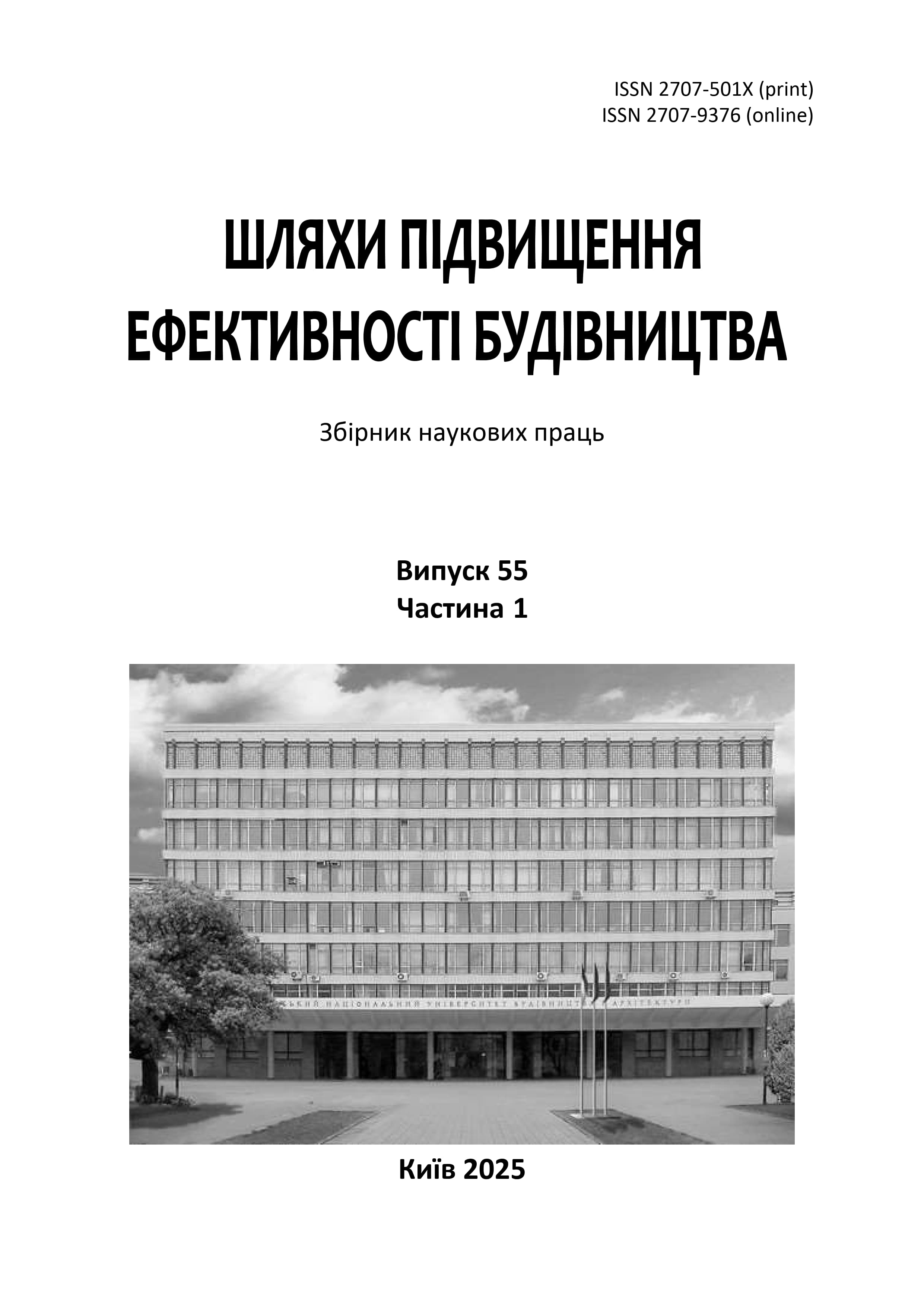Key methodological principles of stakeholder integration into the investment and implementation processes of development construction projects
DOI:
https://doi.org/10.32347/2707-501x.2025.55(1).116-133Keywords:
stakeholders, development project, risk management, digital transformation, construction financing, investors, strategic partnership, blockchain, public-private partnershipAbstract
In modern construction development, the integration of stakeholders into the investment and implementation processes of projects is a key factor in ensuring their efficiency and sustainability. Successful management of stakeholders allows minimizing risks, improving the quality of project implementation and ensuring the stability of financing. The introduction of a systematic approach to stakeholder integration contributes to the optimal allocation of resources, improving communications between participants in the construction process and reducing the likelihood of conflicts.
Modern methodological approaches to stakeholder integration involve the integrated use of financial, management and digital technologies. They are based on the principles of partnership, openness and mutual responsibility of all participants in the development process. Particular attention is paid to the implementation of digital platforms that provide process automation, transparency of financial flows and analytical support for management decisions.
Key aspects of effective integration are the formation of mechanisms for interaction between investors, developers, government agencies, financial institutions and end users. The use of innovative management models, such as public-private partnerships, digital ecosystems and blockchain technologies, allows to increase the level of trust between participants and ensure effective control over the implementation of development projects. Therefore, the integration of stakeholders into the processes of investment and implementation of construction projects is a strategically important direction for the development of development. The use of advanced management methods, analytical tools and digital technologies contributes to the optimal allocation of resources, risk reduction and increased efficiency of the implementation of construction initiatives.
In addition, an important aspect of successful stakeholder integration is the implementation of multi-level management mechanisms, which allows taking into account the interests of all participants in the process. The development of management strategies based on predictive analysis and assessment of potential risks ensures greater adaptability of development companies to changes in the market and the legislative framework. In particular, the use of digital technologies, such as artificial intelligence and big data analysis, allows to significantly increase the accuracy of forecasting and management of financial flows. Also, an important element of stakeholder integration is increasing the level of social responsibility and environmental sustainability of projects. The involvement of environmental standards, principles of sustainable development and the use of energy-efficient solutions helps to improve the reputation of development companies, attract new investors and expand financing opportunities.
References
Chinyio, E.A., Olomolaiye, P.O. Construction Stakeholder Management. John Wiley & Sons, 2009. 416 p. DOI: 10.1002/9781444315349
El-Gohary, N.M., Osman, H., El-Diraby, T.E. Stakeholder Management for Public Private Partnerships. International Journal of Project Management. 2006. Vol. 24, No. 7. Рp. 595-604.
Chupryna Iu., Pokolenko V., Horbach M., Bolebrukh O., Hrabchak D. Model of strategic analysis of formation and administration of investment activity of stockholder construction company. Scientific Journal of Astana IT University, 2020, Volume 3, September 2020, Рp. 51-62. DOI: 10.37943/AITU.2020.19.30.005
Mitchell, R.K., Agle, B.R., Wood, D.J. Toward a Theory of Stakeholder Identification and Salience: Defining the Principle of Who and What Really Counts. Academy of Management Review. 1997. Vol. 22, No. 4. Рp. 853-886.
Бондаренко Р.І. Інтеграція стейкхолдерів у процеси інвестування будівельних проектів. Економіка будівництва. 2018. № 4. С. 45-52.
Василенко В.О. Управління взаємодією зі стейкхолдерами в девелоперських проектах. Менеджмент та підприємництво в Україні: етапи становлення і проблеми розвитку. 2019. № 2. С. 112-118.
Гончаренко О.В. Методологічні підходи до інтеграції стейкхолдерів у будівельних проектах. Вісник Придніпровської державної академії будівництва та архітектури. 2020. № 1. С. 34-40.
Дяченко Л.М. Роль стейкхолдерів у реалізації інвестиційних проектів у будівництві. Економіка розвитку. 2017. № 3. С. 85-91.
Захарченко П.М. Механізми взаємодії зі стейкхолдерами в будівельних проектах. Економіка та держава. 2018. № 5. С. 99-103.
Іванова О.С. Стратегічне управління стейкхолдерами у будівництві. Вісник економіки транспорту і промисловості. 2020. № 69. С. 123-129.
Івахненко І.С., Чуприна Ю.А., Рижакова Г.М., Поколенко В.О. Інноваційний менеджмент: методичні вказівки до виконання практичних занять. Київ: КНУБА, 2024. 64 с.
Коваленко І.В. Інтеграція інтересів стейкхолдерів у будівельних проектах. Економічний простір. 2019. № 151. С. 56-63.
Лисенко М.М. Управління конфліктами між стейкхолдерами в будівництві. Проблеми економіки. 2018. № 3. С. 148-154.
Мельник А.В. Методи оцінки впливу стейкхолдерів на будівельні проекти. Будівельне виробництво. 2017. № 63. С. 72-78.
Downloads
Published
How to Cite
Issue
Section
License

This work is licensed under a Creative Commons Attribution 4.0 International License.
Authors who publish with this journal agree to the following terms:
- Authors retain copyright and grant the journal right of first publication with the work simultaneously licensed under a Creative Commons Attribution License that allows others to share the work with an acknowledgement of the work's authorship and initial publication in this journal.
- Authors are able to enter into separate, additional contractual arrangements for the non-exclusive distribution of the journal's published version of the work (e.g., post it to an institutional repository or publish it in a book), with an acknowledgement of its initial publication in this journal.
- Authors are permitted and encouraged to post their work online (e.g., in institutional repositories or on their website) prior to and during the submission process, as it can lead to productive exchanges, as well as earlier and greater citation of published work (See The Effect of Open Access).

